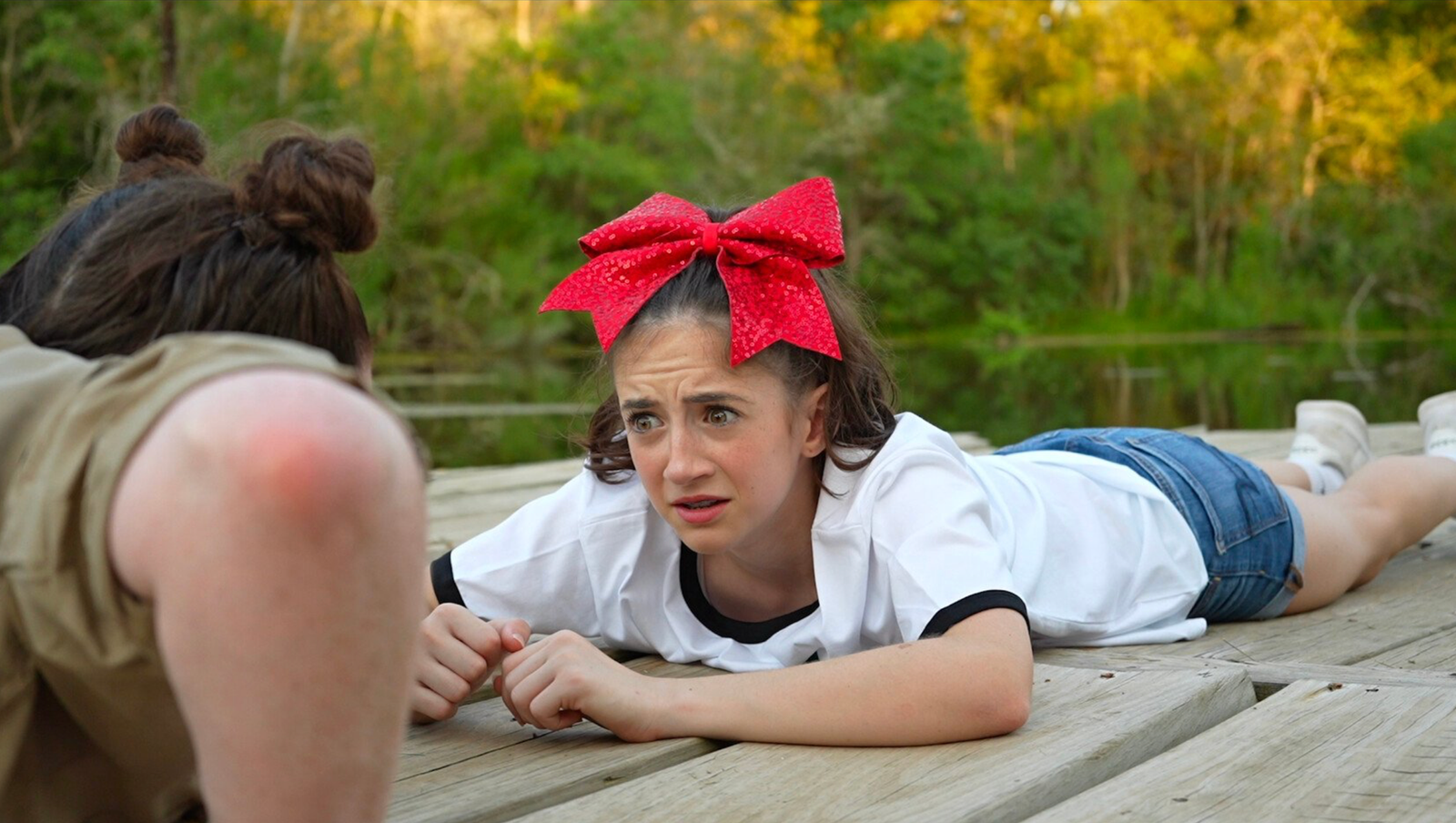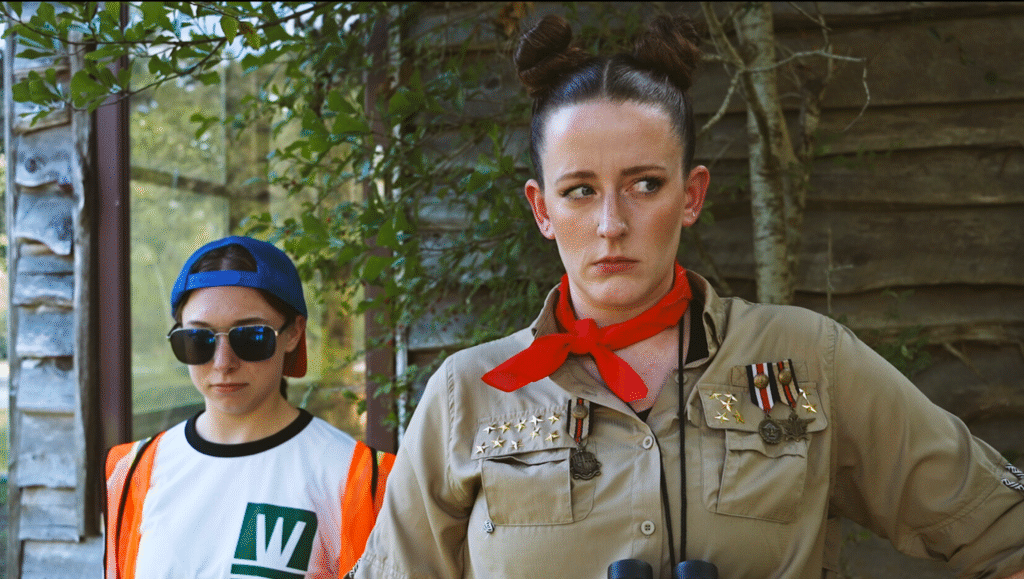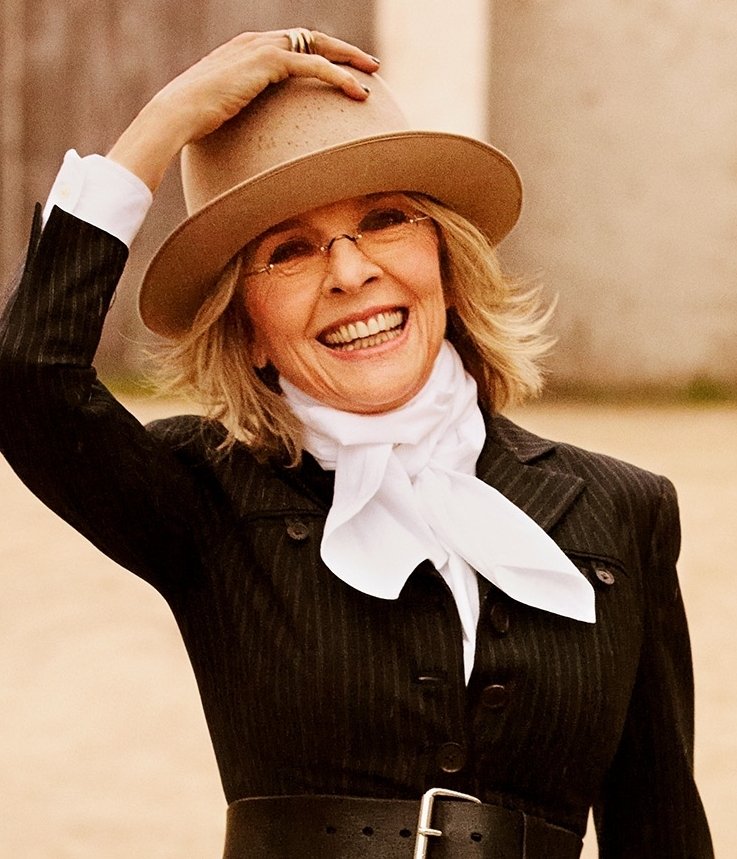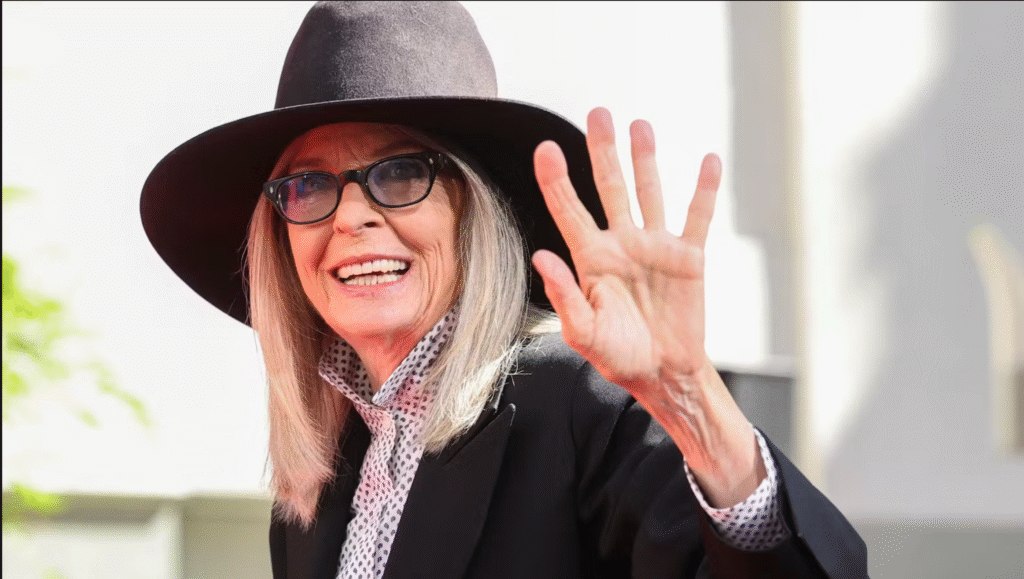Entertainment
Amy Duggar Tell All Book Teaser Promises to Finally Expose Jim Bob on January 28, 2024 at 3:00 pm The Hollywood Gossip
Is Amy Duggar writing a Tell All book?
Fans and critics alike are never entirely sure when the famed Duggar cousin is trolling them.
But right now, she’s teasing a new writing project.
For years, Amy has hoped to expose her despicable uncle and aunt. Is her memoir going to reveal more dirty Duggar secrets?
Amy Duggar appeared on Marriage Boot Camp. (Image Credit: WEtv)
On TikTok, Amy Duggar is teasing a Tell All book … probably
Just days ago, Amy Rachelle King — whom fans know best as Amy Duggar — took to TikTok to upload a teaser video.
In the post, the infamous “black sheep” of the Duggar family wears pajamas and sits in bed while frantically typing on her laptop.
The video includes a series of clips of this nature. Clearly, the compilation implies that she has been typing like this nonstop.
“I’ve been busy lately … #newproject,” Amy captioned the video.
In case the visual contents of the video were too subtle, the instrumental music to the video is a song titled “Write.”
We know that Amy has been writing. The only question is what she has been cooking up.
In 2017, Amy Duggar appeared on Marriage Boot Camp alongside her husband. (Image Credit: WEtv)
Fans have one theory for Amy Duggar and her writing project
Though several commenters commented on Amy’s dramatized, fake typing for the video, others zeroed in on the project itself.
Everyone is assuming that she is working on a Tell All book. A Duggar cousin memoir would be a hot topic among longtime Duggar critics who long to see Jim Bob exposed and deposed (so to speak).
Amy wouldn’t be the first in the family to write a book about her experiences. But she might have some unique perspectives on things … and more to share than her cousins have thus far..
Amy Duggar appears in the recent Amazon documentary series Shiny Happy People. (Photo Credit: Amazon)
Yes, Jinger and Jill both came out with memoirs
Jim Bob and Michelle raised Jinger and Jill in a cult upbringing.
And though Amy’s cousin status allowed her certain freedoms, she spent more than enough time growing up under that roof to see what their extreme lifestyle is really like.
Jill came out with Counting The Cost. Jinger came out with Becoming Free Indeed. But neither Duggar daughter seemed fully prepared to unload on Jim Bob as he deserves.
Look out, Michelle and Jim Bob! Jill Duggar has come out with a book that exposes just how evil you truly are. (Photo Credit: Amazon)
Jill’s memoir focused upon the finances and deceit
For Jill Duggar and husband Derick Dillard, much of the breaking point — the focus of their outspoken anger — had to do with Jim Bob’s dishonesty.
True, they are not raising their children in the cult. They are even giving their children an actual chance at life, sending them to actual schools.
But they have worked to expose Jim Bob for how he underpaid them (until they were ready to take him to court), collecting TLC paychecks for himself while telling his family that their reality TV jobs were a form of ministry.
Jinger Duggar is attracting a lot of attention these days. And much of it has to do with her memoir. (Image Credit: YouTube)
Jinger isn’t prioritizing exposing Jim Bob for one key reason
Yes, Jinger has spoken about her criticisms the way that her awful parents raised her. And she does want to expose the IBLP cult and its notorious founder.
But in Becoming Free Indeed and in interviews, Jinger is so reluctant to speak too harshly because she worries that it could reflect poorly upon all of Christianity.
In fact, it often sounds like her primary concern is that these fundamentalist organizations and beliefs hurt the brand of Christianity. That’s not an unfair concern … but Jinger’s priorities weakened her memoir.
Amy Duggar and her husband, Dillon King, speak to the Marriage Boot Camp confessional camera. (Image Credit: WEtv)
Is Amy Duggar the best person to write a Tell All book?
Truth be told, the best Duggar Tell All would be from someone who is no-contact with the main Duggar family, grew up in that household, and is a full apostate.
Even Jill still talks to sisters, and so she has ties to Jim Bob and Michelle in that sense. Jinger hangs out with family. Both remain devout Christians with very conservative beliefs outside of mainstream American Christianity.
One day, maybe a LGBTQ+ Duggar offspring will break ranks and cut all ties. That person could write a perfect Tell All.
During her season on Marriage Boot Camp, Amy Duggar was — at times — not a happy camper. (Image Credit: WEtv)
Until then, maybe a “Famy” Amy Duggar Tell All is our best option
Yes, she seems to like attention. And yes, Amy Duggar’s NDA is probably going to be an obstacle in anything that she does.
But Amy has the least to lose if Jim Bob goes to war with her. Some of her cousins cannot say the same — especially those who depend upon him for financial support.
If Amy does come out with a memoir, we’ll be intrigued to hear what she (and the likely ghostwriter) has to say.
Amy Duggar Tell All Book Teaser Promises to Finally Expose Jim Bob was originally published on The Hollywood Gossip.
[[{“value”:”Is Amy Duggar writing a Tell All book? Fans and critics alike are never entirely sure when the famed Duggar …
Amy Duggar Tell All Book Teaser Promises to Finally Expose Jim Bob was originally published on The Hollywood Gossip.”}]]
The Hollywood Gossip Read More
Entertainment
California Bans AI Clones from Replacing Real Talent

California just made a dramatic stand for human creativity, defeating the threat of AI actor clones with a sweeping new law that puts people—not algorithms—back in the Hollywood spotlight. With the stroke of Governor Gavin Newsom’s pen in October 2025, the state has sent a clear message to studios, tech companies, and the world: entertainment’s heart belongs to those who create and perform, not to digital facsimiles.
California Draws a Hard Line: No More AI Clones
For months, the entertainment industry has been divided over the use of artificial intelligence in filmmaking. Studios, lured by promises of cost-cutting and creative flexibility, have invested in software that can mimic an actor’s face, voice, and even emotional range. But for performers, this wave of synthetic reproduction has triggered alarm—encouraged by chilling stories of deepfakes, unauthorized digital doubles, and contracts that let studios reuse a star’s likeness indefinitely, sometimes without pay or approval.
The new California law, anchored by AB 2602 and AB 1836, changes everything:
- Every contract must explicitly detail how studios can use digital replicas or voice models, preventing once-common “blank check” agreements that overlooked this risk.
- No one—not studios nor streaming giants—can create or release AI-generated clones of an actor, living or dead, without clear, written consent from the performer or their estate.
- The law gives families new powers to defend loved ones from posthumous deepfake exploitation, closing painful loopholes that once let virtual versions of late icons appear in new ads, films, or games.
Actors Celebrate a Major Victory
The legislation rides the momentum of the recent SAG-AFTRA strike, where real-life talent demanded control over their own digital destinies. Leaders say these protections will empower artists to negotiate fair contracts and refuse participation in projects that cross ethical lines, restoring dignity and choice in an industry threatened by silent algorithms.
Stars, unions, and advocacy groups are hailing the law as the most robust defense yet against unwanted AI replications.
As one actor put it, “This isn’t just about money—it’s about identity, legacy, and respect for real artists in a synthetic age.”
A New Chapter for the Entertainment Industry
California’s move isn’t just a victory for local talent—it’s a warning shot to studios everywhere. Companies will now be forced to rethink production pipelines, consult legal counsel, and obtain proper clearance before digitally cloning anyone. Global entertainment platforms and tech developers will need to comply if they want to do business in the world’s entertainment capital.

These laws also set a template likely to ripple through other creative fields, from musicians whose voices can be synthesized to writers whose work could be mimicked by generative AI. For now, California performers finally have a powerful shield, ready to fight for the right to shape their own public image.
Conclusion: Human Talent Takes Center Stage
With its no-nonsense ban on AI actor clones, California draws a bold line, championing the work, likeness, and very humanity of its creative stars. It’s a landmark step that forces the entertainment industry to choose: respect real talent, or face real consequences. The age of the consentless digital double is over—human performers remain the true source of Hollywood magic.
Entertainment
Chaos and Comedy: Darby Kingman’s “Camp Wackapoo: Rise of Glog”

Darby Kingman’s “Camp Wackapoo: Rise of Glog” redefines summer camp comedy with a wild, energetic story about ambition, chaos, and the joy of embracing the unexpected. The film centers on a relentlessly competitive camp counselor who’s determined to finish first—only to face a motley crew of unruly campers and a summer unlike any other.
As Darby puts it, “Not everything is that deep. It really honestly was to make people laugh. She has all these kids that are not working with her and she’s just losing her mind. It’s crazy, silly, goofy, and it was a blast.”
What started as a simple scene for Darby’s acting reel evolved into a full-fledged film with encouragement from her mentor at Debbie Reynolds Acting School. Darby dove into every role—writing, directing, starring, and meticulously preparing each prop and costume. “Plan and prepare, but also be flexible and ready to be in the moment—that’s when the magic happens,” she advises.
Working with a handpicked cast of her own dance students, Darby built an atmosphere of real teamwork and camaraderie. She credits the “precious” energy of her young cast, her creative director of photography, and the overall spirit of her production team for turning the project into something bigger than herself. Her experience is an inspiring blueprint for indie filmmakers:
“Take initiative and control of your career. You can’t just sit around and wait for somebody to pick you. Figure out what you’re good at and go for it. Create something that brings joy to others.”

Her production motto? “Preparation is key, but you have to be ready to go with the flow—that’s when the magic happens.” Darby’s fearless creativity, focus on collaboration, and love for comedy shine throughout “Camp Wackapoo: Rise of Glog.” It’s more than just a camp satire—it’s a heartfelt testament to hard work, original humor, and leadership from the ground up: “People need to laugh right now. That’s a win.”
Catch “Camp Wackapoo: Rise of Glog” and experience Darby’s infectious energy and comic genius at the Deluxe Theatre on November 1, 2025. Get your tickets now at Houstoncomedyfilmfestival.com.
Entertainment
Diane Keaton Dies at 79

The world of film and entertainment is mourning the loss of Diane Keaton, an Oscar-winning actress renowned for her enduring talent, individuality, and influence on generations of performers and fans. Keaton died at the age of 79 in California on Saturday, October 11, 2025, her family confirmed. Details remain private, with her family requesting privacy as they grieve this profound loss.

A Distinctive Talent
Diane Keaton rose to fame in the 1970s through a series of memorable roles, most notably as Kay Adams in “The Godfather” trilogy and as the quirky, unforgettable lead in Woody Allen’s “Annie Hall,” for which she won the Academy Award for Best Actress. Her performances in films like “The First Wives Club,” “Something’s Gotta Give,” and the “Book Club” series solidified her reputation as an actress with unique comedic timing and dramatic depth. Keaton was celebrated not only for her artistry but also for her androgynous fashion sense, characterized by menswear-inspired looks, hats, and an easy, effortless style that influenced generations.
Legacy and Tributes
Following the news of her passing, tributes poured in from Hollywood and beyond. Bette Midler, Goldie Hawn, and Jane Fonda were among the countless stars who expressed devastation and admiration for Keaton’s incomparable legacy. Hawn recalled their friendship and collaborations, writing: “Diane, we aren’t ready to lose you…you stole the hearts of the world and shared your genius with millions”. Midler echoed the sentiment, praising Keaton as “brilliant, beautiful, extraordinary” and a truly original presence in Hollywood.

Private Struggles and Final Months
Though fiercely independent and known for her openness, Keaton kept her declining health private in her final months. Friends and neighbors noticed her retreat from public life and social media, and she was recently seen less often in her Brentwood neighborhood. In the past, Keaton candidly discussed her ongoing battles with skin cancer and bulimia, openly advocating for personal health and authenticity.
Remembering Diane Keaton
Diane Keaton leaves behind a legacy defined by her fearless performances, unique style, and enduring influence on the arts. She is survived by her two children, Dexter and Duke. As Hollywood and her global fanbase mourn, her pioneering spirit and unmistakable voice will continue to inspire generations.

 Business4 weeks ago
Business4 weeks agoDisney Loses $3.87 Billion as Subscription Cancellations Surge After Kimmel Suspension

 Entertainment4 weeks ago
Entertainment4 weeks agoWhat the Deletion Frenzy Reveals in the David and Celeste Tragedy

 Entertainment4 weeks ago
Entertainment4 weeks agoExecutive Producer Debut: How Celia Carver Created Festival Hit ‘Afterparty’

 Film Industry4 weeks ago
Film Industry4 weeks agoCan Movie Theaters Steal the Show from Streaming?

 Health4 weeks ago
Health4 weeks agoRussia Claims 100% Success With New mRNA Cancer Vaccine

 News4 weeks ago
News4 weeks agoBody of Missing Teen Found in Tesla Linked to Musician D4vd

 Business4 weeks ago
Business4 weeks agoWhy Small Theaters Are Thriving While the Industry Struggles

 Business2 weeks ago
Business2 weeks agoWhy Are Influencers Getting $7K to Post About Israel?





























